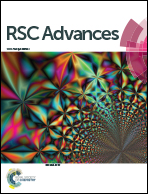Novel functionalized pillar[5]arene: synthesis, assembly and application in sequential fluorescent sensing for Fe3+ and F− in aqueous media†
Abstract
We designed and synthesised a novel copillar[5]arene PF5 that can through self-inclusion produce strong blue fluorescence. The pillar[5]arene-based chemosensor PF5 could be a sequential fluorescence sensor for ferric ions (III) followed by fluoride ions with high sensitivity and selectivity in aqueous solutions. When Fe3+ was added to the solution of the sensor PF5, the blue fluorescence emission was quenched. After the addition of F−, the blue fluorescence emission of the PF5–Fe3+ system returned to the original level. PF5 has specific selectivity to Fe3+ and common cations (Hg2+, Ag+, Ca2+, Cu2+, Zn2+, Cd2+, Ni2+, Pb2+, Co2+, Cr3+, Mg2+, Fe2+, and Al3+) could not interfere with the detection process. In addition, PF5–Fe3+ has specific selectivity to F− and common anions (Cl−, Br−, I−, AcO−, NO3−, HSO4−, ClO4−, SCN−, and CN−) and does not interfere with the detection process. The detection limit of the sensor PF5 for Fe3+ was 9.0 × 10−7 mol L−1, and the detection limit of F− was 2.59 × 10−8 mol L−1. Moreover, test strips based on the sensor were fabricated, which could be very good sequential test kits for ferric ions (III) and fluoride ions. Moreover, the sensor PF5 could also sequentially detect Fe3+ in tap water and F− in toothpaste.
![Graphical abstract: Novel functionalized pillar[5]arene: synthesis, assembly and application in sequential fluorescent sensing for Fe3+ and F− in aqueous media](/en/Image/Get?imageInfo.ImageType=GA&imageInfo.ImageIdentifier.ManuscriptID=C5RA26240B&imageInfo.ImageIdentifier.Year=2016)

 Please wait while we load your content...
Please wait while we load your content...